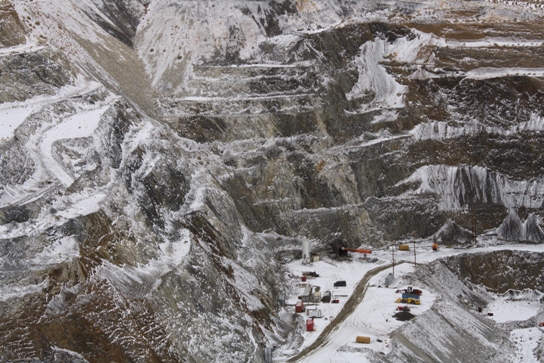Atna Resources (ATN-T) took a beating after notifying the market that it would reduce underground mining rates at its Pinson gold mine near Winnemucca, Nev.
Pinson — which had been expected to reach commercial production of 750 tons (680 tonnes) per day and generate positive net cash flows by year-end — is now under review given the recent decline in gold prices. On the news, Atna shares plunged 43% to close May 30 at 24¢. It fell another 12% to 21¢ before the month was over.
Atna’s vice-president of exploration William Stanley says that Pinson’s mining rate will be lowered and the workforce temporarily reduced by up to 50%, while retaining key personnel to keep Pinson running.
“It’s going to keep producing gold at 100 to 150 tons per day, and our current estimates are at this reduced rate. By exploiting the existing reserves that have been developed, we will essentially be at a break-even for the remainder of the year while we complete this evaluation,” Stanley says.
Canaccord Genuity analyst Rahul Paul said in an email that “I think mining at those rates will barely cover maintenance and overhead at Pinson underground. The best case would be that it would simply stop the cash burn.” He adds that this new mining “is effectively care and maintenance, as they’re trying to generate enough cash to pay for the maintenance.”
As part of the review, the Golden, Colo.-based junior is looking at Pinson’s entire operation — including the mine plan, mining and processing methods, and contractor costs — to determine if it can run the mine more efficiently, Stanley says.
Consequently, Atna has withdrawn Pinson’s 2013 production guidance. The underground mine was previously estimated to churn out 50,000 to 57,000 oz. gold at a cash cost of between US$900 and US$950 per oz. Atna noted that most of the output would have come online in the last half of the year, with total costs averaging US$1,025 to US$1,180 per oz.
“This comes as a major surprise . . . a shift in management’s outlook from the first-quarter 2013 conference call,” Paul writes in a note.
He suggests the latest move brings into question management’s credibility, because a May 2012 technical report outlined strong economics at the project, including all-in-costs of US$1,067 per oz. and an internal rate of return of 103% at US$1,300 per oz. gold. He adds that the fate of the operation has become uncertain even at today’s higher gold price of around US$1,400 per oz.
“To be fair, the capital-operating cost outlook can change substantially over a twelve-month period and can adversely impact the economics of any mining project. But in this case, it is difficult for us to comprehend what may have gone wrong,” Paul says.
Atna’s Stanley maintains that the review resulted from the recent gold price drop and the fall in production and ounces sold at the company’s flagship Briggs gold mine in California, which affected the amount of capital available to spend at Pinson.
“Our Briggs gold mine was producing much of the cash that was required to be invested in the project,” Stanley says.
During the first quarter Briggs generated 8,000 oz. gold and sold 7,700 oz., with quarter-over-quarter production and gold sales dropping 28% and 20%, largely due to less ore being available to mine, as Atna focused on pre-stripping new pit areas.
This drove up the mine’s first-quarter waste-to-ore strip ratio to 7.1 compared to 2.9 in the last quarter of 2012. However, the junior expects that ratio to average 4.8 tons (4.4 tonnes) this year, as it strips the new pits in the second quarter.
“So during the third quarter and fourth quarter going forward at Briggs, we should see the strip ratios drop and a pick-up in the gold production that will help us going forward with our investments at Pinson, and potentially reward us late in the year or early next year,” Stanley says.
While the company re-examines Pinson’s underground mine and alternative financing routes, it has initiated an open-pit feasibility study and is contemplating running the project as a combined operation.
Pinson ran as an open-pit mine from 1980 to 1999, producing 985,000 oz. gold during that time.
But Paul remains cautious. “At this stage, we are not convinced that the cost structure at Pinson can be improved without more capital infusion. With likely no recourse to additional capital in today’s market, we assume Pinson underground will remain suspended under Atna’s ownership,” he says.
The company ended the first quarter with US$5.9 million in cash and equivalents — excluding the US$1.1 million it received in a late March sale at Pinson, where it sold 8,345 tons (7,570 tonnes) of oxide ore containing 1,242 recovered oz. gold.
In the first-quarter, Pinson mined 9,896 tons containing 2,735 gold oz. in oxides and sulphides.
Paul has downgraded his target price to 30¢ from $1.50, and its “speculative buy” rating to “hold.”


Be the first to comment on "Atna sinks on Pinson review"